Noise Control and Isolation for Multi-Family/Mixed Use Construction
Stud design and noise attenuating assemblies for floors, ceilings and walls address stress provoking intrusive noise
![]() Continuing Education
Continuing Education
Use the following learning objectives to focus your study while reading this month’s Continuing Education article.
Learning Objectives - After reading this article, you will be able to:
- Summarize the basic principles of noise propagation and architectural acoustics as they relate to multi-family and mixed-use construction.
- Discuss the importance of addressing sound control during the design stage.
- Evaluate and select effective sound control building assemblies that meet both code requirements and design goals.
- Identify design options, products and materials for improved sound isolation of airborne and impact generated noise.
Multifamily housing is becoming increasingly appealing to both developers and homeowners. The advantages of city life with its walk-to restaurants, stores, and minimal commute are attracting empty nesters and an aging population. Even suburban dwellers are increasingly valuing the benefits of high-density living with its absence of yards to care for. Statistics are supporting this change in life style. The Multifamily Production Index (MPI), a leading indicator for the multifamily market released by the National Association of Home Builders (NAHB), posted a gain of five points to a reading of 58 for the second quarter of 2014—the 10th straight quarter with a reading of 50 or above.
According to the U.S. Green Building Council (USGBC) sound transfer is one of the biggest complaints of multi-family and attached single family living, as well as city living. Moreover, elevated noise levels increase stress and stress related health issues for occupants of all types of multi-family housing, from subsidized housing to luxury condos. Yet attention to acoustics is often put on the back burner by developers and design professionals, despite the potential for litigation by distressed occupants. Luxury projects are mostly marketed for location, views, amenities and like-minded neighbors—not their acoustical performance, which is often ill understood or ignored. Not only music-playing neighbors, but sounds of high heels walking normally on the floor above, can negate an apartment’s appeal—particularly for occupants who have downsized from a single family home and are unaccustomed to hearing normal noise from neighbors.
Attention to acoustics and sound isolation as they meet and exceed code requirements during the design phase is critical, since reconstruction for acoustical remediation is both significantly more expensive and impractical to implement.
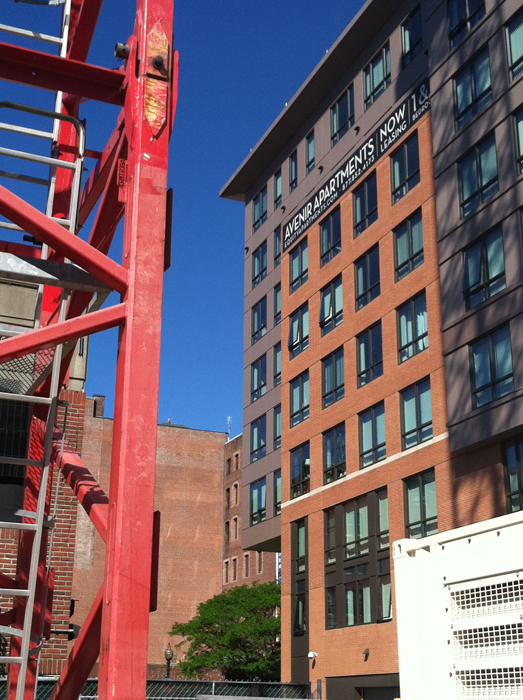
Photo courtesy of Kinetics Noise Control
Acoustical performance in multi-family housing is often ignored by design professionals.
Unlike concert halls, office buildings or entertainment facilities, where the time and place of sound emissions are mostly predictable and manageable, multi-family and mixed use buildings have many people doing different things in their own homes and businesses during all times of the day and night. Since neither the source of sound or noise, nor the receiver or listener can be controlled, the only means of addressing disruptive sounds is to treat the path of the sound by utilizing effective construction acoustical treatments.
Basic Concepts of Sound
Sound travels in waves. In air, sound is produced by fluctuations in air pressure. In solid building materials, sound can be produced by impact and vibration and progresses as vibration. What we hear are fluctuations in air pressure produced by the vibrating surfaces. Airborne sounds in multifamily dwellings include speech, music, noisy HVAC equipment, air and street traffic. Examples of structure-borne sounds include furniture moving on the floor, a toddler jumping about, and even an adjacent railway or parking garage.
Decibel (dB)
The decibel is commonly used in acoustics to quantify sound levels relative to a 0 dB reference, the typical threshold of perception of an average human.
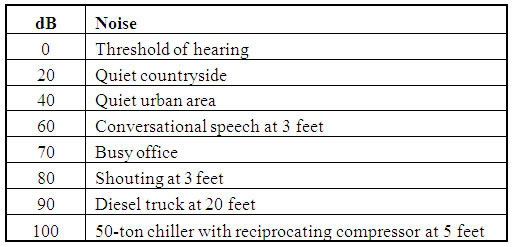
Provided by Kinetics Noise Control
Decibel levels of different sounds
In noise control, a 3 dB sound reduction is just perceptible, a 6 dB reduction is noticeable and lowering sound 10 dB halves the perceived sound.
Sound Wavelength
High frequency sounds have a shorter wavelength. A 2000 Hz sound, for example, has a 7-in. wavelength. Low frequency sounds have a longer wavelength; a 125 Hz (low frequency), for example, has a 9-ft wavelength.
Low frequency (longer) sound waves are difficult to control with standard building materials. Standard wood joist and single stud construction allows noise transfer, while hard finish floors such as tile, wood, and vinyl, on concrete or wood subfloors, readily transmit impact noise. The design of a floor/ceiling assembly, for instance, will depend on the frequencies needing to be controlled.
Architectural Acoustics
There are four major aspects of architectural acoustics:
1. Isolating sound between rooms.
2. Managing acoustics within spaces; typically by controlling reverberation.
3. Managing HVAC/Plumbing/Electrical Equipment (MEP) vibration and noise control.
4. Active audio systems such as white noise generators and noise cancelation.
This course about noise control in multifamily and mixed-use construction will concentrate on the first aspect—isolating sound between rooms and demising walls (boundaries that separate one tenant's space from that of the other, and from the common corridor).
The second aspect that focuses on acoustics within spaces is addressed by interior treatments rather than by construction methods. The third aspect of MEP vibration and sound control does contribute to noise problems in multi-family projects, as does the fourth aspect of specifying active audio systems, but they will not be fully addressed here.
Achieving Sound Isolation in Multifamily/Mixed-Use Construction
Noise control for multi-family/mixed use can be challenging as there are many sources for potential noise problems. There are obvious concerns for the neighbor’s loud television, the jumping toddler, and the barking dog. Other noise sources are less obvious—traffic noise, flyover noise, mechanical equipment noise, even noise that can breakout several stories above a gymnasium on grade when weights are dropped on the floor.
Proper planning is essential for noise control as there are many variables to consider. The materials selected for construction, head of wall details, the span of subfloor, even the gauge selected for metal studs all have an impact on quiet building construction. If noise control products are to be employed, room/hallway transitions, multiple layers of drywall for walls and ceilings, and contractor education need to be part of the planning. Addressing these and other issues during the design stage is not only critical, but yields the most economical and practical solution to noise control. In order to select the most effective noise control building system and materials, design professionals are well served by consulting an acoustical engineer. Leading manufacturers should assist by providing specifications, product performance and fire test reports of sound attenuating products on their web sites. They should also be able to offer insight on installation methods as well as product construction details in AutoCAD and PDF format.
Sound transmission class (STC) and impact insulation class (IIC) are two performance values associated with sound isolation between rooms. Both STC and IIC ratings apply to assemblies, not to individual products.
Sound Transmission Class (STC)
STC is a numerical rating of how well a building partition attenuates airborne sound. In the U.S., it is widely used to rate interior partitions, ceilings/floors, doors, windows and exterior wall configurations (see ASTM International Classification E413 and E90.) The measurement is heavily weighted in the 1000 to 4000Hz frequency. Normal speech can be clearly understood through a wall with an STC of 30. At STC 40 speech can be heard with some effort. At STC 60 loud speech is inaudible but loud music can still be heard, especially loud bass notes.
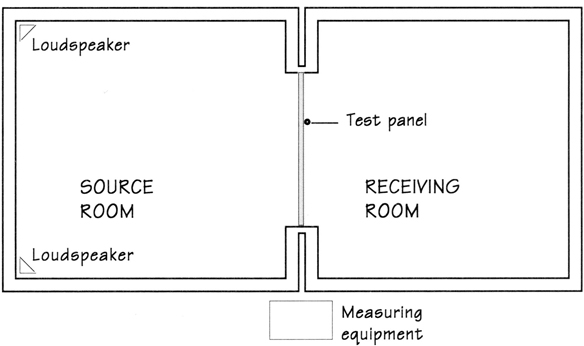
Drawing courtesy of Kinetics Noise Control
STC testing is conducted in an acoustical lab.
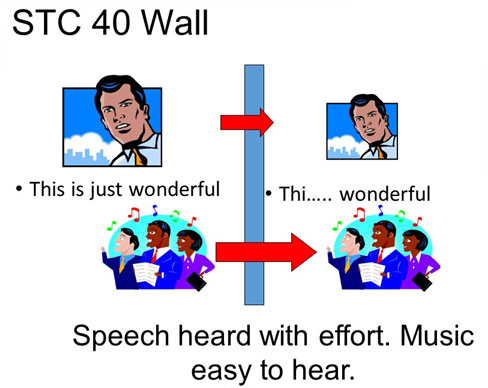
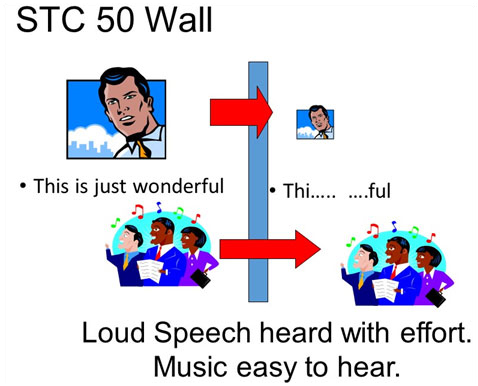
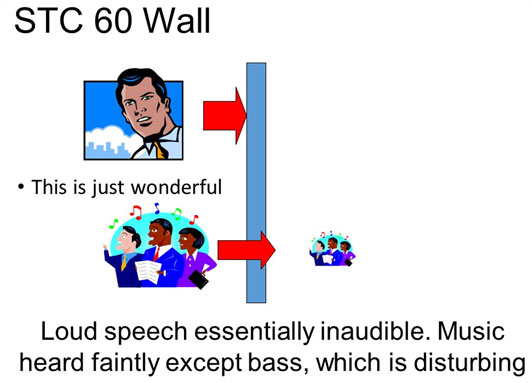
Images courtesy of Kinetics Noise Control
STC values rate how construction barriers attenuate sound.
Impact Insulation Class (IIC)
IIC is a single number rating that provides a means of comparing the acoustical performance of floor-ceiling assemblies, when excited by impact. Such structure-borne noises include footsteps, pans and toys dropping to the floor, chair movements, exercise equipment, trash chutes, exterior surface traffic. A larger number means more attenuation. IIC values are obtained through laboratory testing.
International Building Code allows for field-testing of STC and IIC, which are referred to as FSTC and FIIC, respectively. These sound tests utilize the same lab testing methods as IIC and STC in the lab, but are conducted in an actual building after the floor-ceiling installation is completed.
One criticism of both the STC and IIC standard is that many bothersome low frequency noises—such as heavy impacts and subwoofers—are not part of the test frequency range. The wavelengths associated with these frequencies are quite large and can be difficult to control. An acoustical consultant should be directed to analyze proposed construction should these noises be a concern.
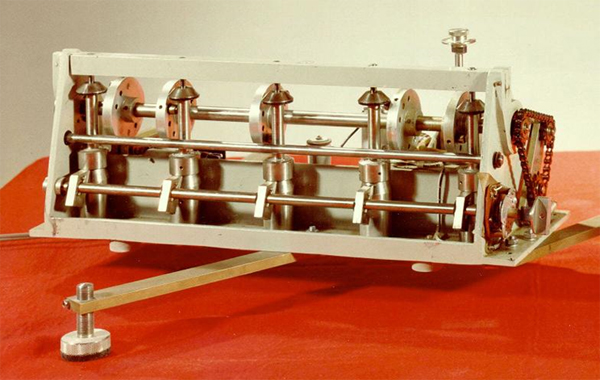
Photo courtesy of Kinetics Noise Control
Example of a tapping machine used to measure impact sound transmission of floor-ceiling assemblies.
Codes versus practical design requirements
What the codes say:
*The Uniform Building Code (UBC) for multi-family construction requires a minimum of STC of 50 for walls between occupant units. It also requires a minimum IIC and STC of 50 for walls and floor-ceiling assemblies.
*The U.S. Department of Housing and Urban Development guidelines recommend a slightly higher STC and IIC in multi-family units that are considered “luxury” in terms of cost and design: minimum of 55 for STC and IIC.
*FSTC and FIIC ratings five points below corresponding STC and IIC lab test ratings are allowed by code.
*Some state and local code authorities are stricter in enforcing requirements for STC and IIC between units.
While the above STC and IIC minimum ratings are code compliant, they usually do not meet noise attenuation requirements for any multi-family subsidized or high-end project. Acoustical consultants will often recommend STC/IIC values in the 60-plus range, especially for luxury residences.
Understanding and Utilizing Acoustical Test Data
With the various types and combinations of building materials available to the industry, it is not surprising that the sound test results among different floor/ceiling assemblies may vary significantly, depending on the assembly design and materials used. Manufacturers offering STC/IIC/FSTC/FIIC values should be prepared to supply a complete copy of the appropriate test(s). Design professionals should be suspicious if a copy of a test with a complete description of the tested assembly is not or cannot be provided.
Field-testing. In order to make comparisons of different products/assemblies, identical assembly systems must have been tested. Design professionals are advised to construct wall/floor/ceiling mockups on site for FSTC/FIIC testing. FSTC/FIIC tests should be performed to the appropriate standards by an acoustical consultant. If the proposed systems are tested under identical conditions, head-to-head comparisons are possible. In addition, subjective testing through site visits to similarly constructed systems can be useful.
Sound Isolation Assemblies
Multi-family construction can take the form of stick built duplexes to concrete deck high-rise luxury towers. Mixed use projects may employ a concrete deck to separate the commercial from the residential levels and then use wood frame for subsequent floors. Floor/ceiling sound isolation assemblies can easily be divided between concrete construction and wood frame. Within these divisions, noise control products are typically broken out between ceiling side and floor side noise treatments (sometimes both sides are necessary). Lastly there are different levels of performance within the flooring products and ceiling products, each with its own requirements for proper installation (typically these include overall height and amount of material required for floor/ceiling assembly). The challenge for the designer is to select the assembly that provides the required level of noise control performance without breaching the design constraints (exposed deck ceilings, flooring transitions, ceiling height, etc.).
Airborne and structure-born sounds between rooms can be managed by specifying architectural sound isolation assemblies. According to one leading manufacturer, additional costs for adding acoustical products to typical concrete and wood frame construction are $0.75 to $1.75 per sq ft.
High performing sound isolation assemblies utilize three principles:
*Mass of construction materials such as concrete slabs or plywood subfloors.
*Airspace between construction components.
*Resilient isolation element used to integrate mass and airspace.
Leading manufacturers offer a wide range of resilient sound isolation products that can help deliver desired STC and IIC values.
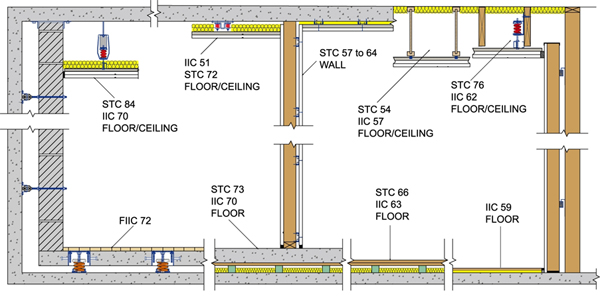
Drawing provided by Kinetics Noise Control
Acoustical design using sound isolating products can achieve predictable STC and IIC values.
The scale on some of the images is exaggerated to better illustrate the acoustic design strategy.
Wood Frame Construction: Floors
Wood frame construction, by its nature can present noise control challenges. As mentioned earlier, mass is a necessary part of noise control. While gypsum concrete is often added to wood frame assemblies, one can expect an obvious drop-off in airborne noise control when compared with the mass of a six-inch concrete deck. The stiffness of a floor is an indicator of how well it will transmit low frequency “thuds”. More flexible assemblies such as wood frame and even lightweight steel decking and concrete do a poor job mitigating impact noise due to the higher deflection of these systems. The trend away from carpet towards hard floor surfaces such as hardwood flooring, ceramic tile, quarry tile, marble, wood parquet, and vinyl tile are all areas where impact noise is of concern.
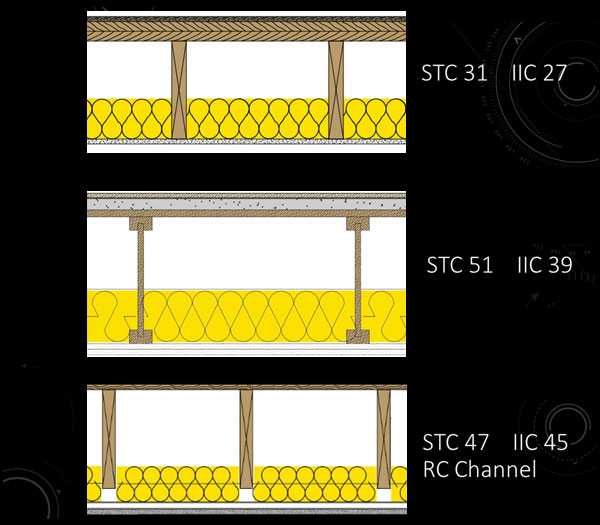
Images courtesy of Kinetics Noise Control
Typical assemblies of wood frame construction that has no sound isolating products
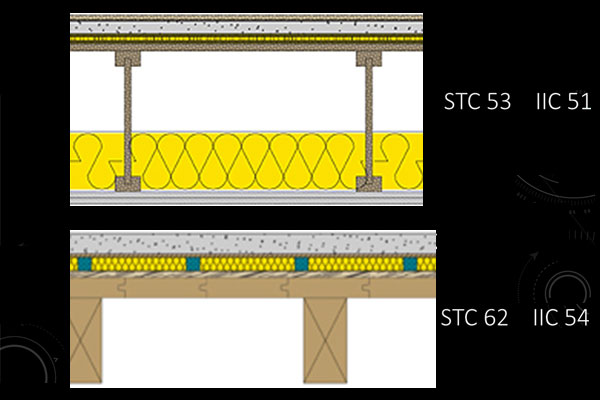
Images courtesy of Kinetics Noise Control
Sound isolating assemblies for wood frame construction. Noise control is addressed from the floor side:
Top: continuous floor underlayment.
Bottom: noise control is provided by creating an air space while maintaining an exposed wood ceiling. This solution is often used for industrial/loft/condo reconstruction.
NB drawings are not at the same scale.
Wood Frame Construction: Ceilings
Spring isolation hangers. These are best for lower frequency noise control. Secured to wood-frame construction (e.g., joists, trusses), a typical hanger incorporates a one-inch-rated deflection spring in series with a neoprene cup, and will typically support two or more layers of gypsum board.
Leaf spring hanger. An innovative approach, the leaf spring ceiling hanger out-performs a resilient channel for wood-framed projects with or without gypsum concrete. The leaf spring design delivers effective noise control for annoying lower frequencies.
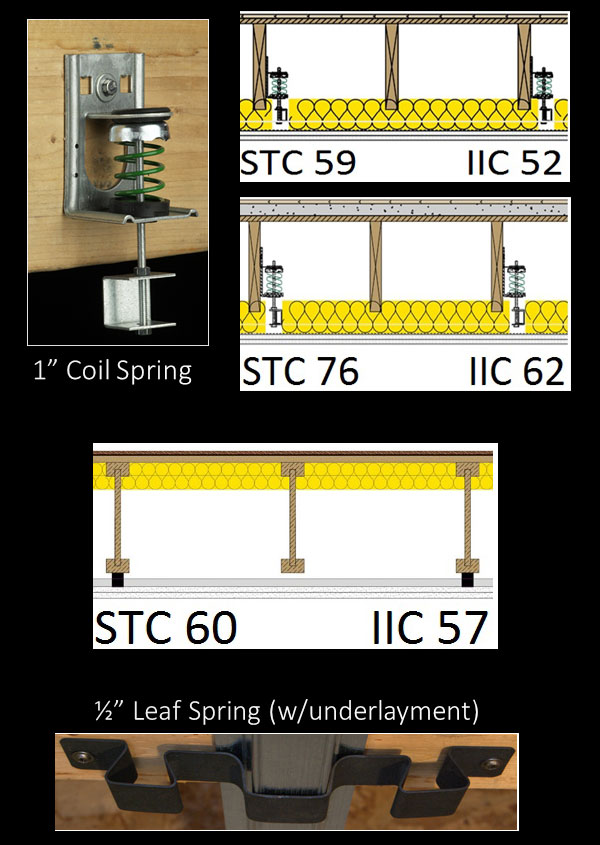
Images courtesy of Kinetics Noise Control
Noise control options for wood frame ceilings.
Top and middle: 1in. coil spring will meet building codes.
Bottom: ½ in. leaf spring hanger with underlayment provides STC of 60 and IIC of 57.
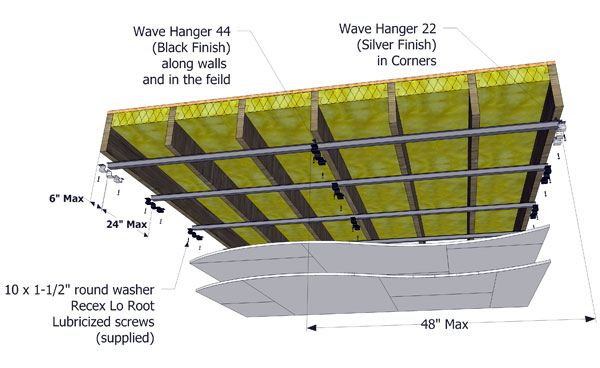
Drawing courtesy of Kinetics Noise Control
Construction details for installing a leaf spring hanger.
Concrete Deck: Floors
Relativity stiff and massive concrete floors still can have poor, less than code, impact ratings. With no additional sound isolation system, a 6-inch concrete slab has an STC of 53 and an IIC of 27, so treatment of at least the impact noise is necessary to meet code.
Adding properly engineered resilient materials in the middle of the floor/ceiling sandwich will increase STC and IIC.
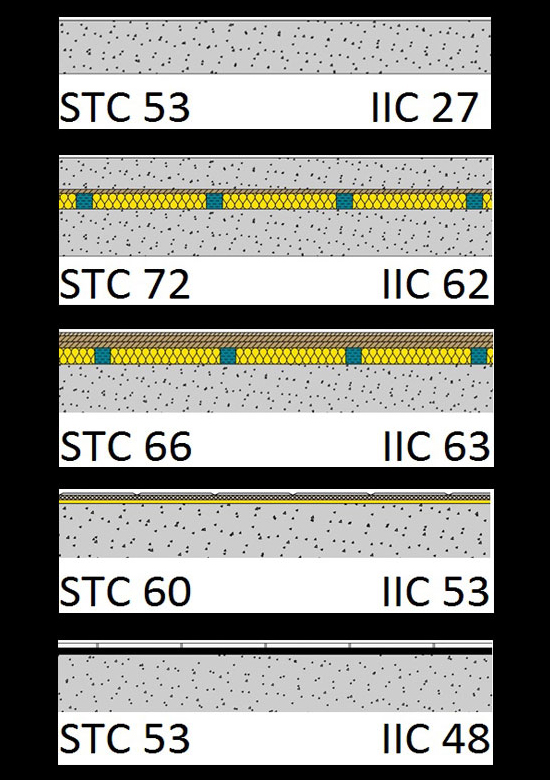
Images courtesy of Kinetics Noise Control
Options for ceiling noise control in concrete construction.
Top: Concrete construction with no noise control
Second from top: Creating a true air space with insulation sandwiched between concrete.
Third from top: Creating a true air space with wood floor on top instead of concrete.
Second from bottom: Continuous floor underlayment.
Bottom: Continuous low-profile floor underlayment, sometimes manufactured from recycled tires.
Roll-out isolation material. One typical roll-out isolation system creates an airspace of one to four inches with resilient isolators spaced according to design criteria. The roll-out isolation material can be installed beneath a “floated” concrete slab or other built up floor system utilizing cross-laid plywood sheathing. Installed between concrete slabs, the assembly STC and IIC can be 72 and 62 respectively. These values surpass the performance of continuous underlayments due to the airspace and lower natural frequency created by the isolators. While not typically used throughout residential units, this systems is used in gymnasiums and shared theater spaces in larger condominiums towers and similar projects.
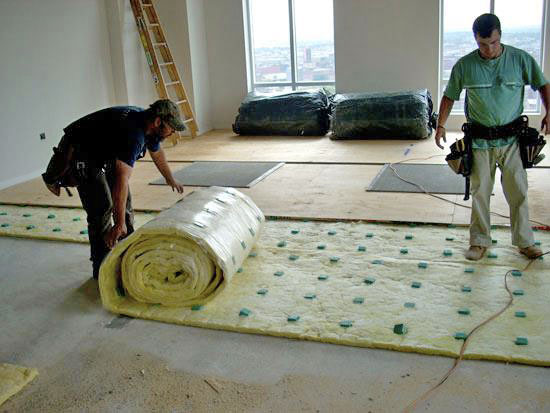
Image courtesy of Kinetics Noise Control
A concrete slab covered in roll-out isolation material with resilient pads supporting a plywood and hardwood finish floor increases STC to 66 from 53 and IIC to 63 from 27.
Low profile underlayment. While having lower STC and IIC values than 1-to 4-inch-thick pads and batting, low profile resilient underlayments are a lower cost material primarily designed to improve the impact noise rating (IIC). If used directly under gypsum concrete, ceramic tile, wood, and vinyl sheet can meet and exceed building code for impact noise. It can facilitate construction of low-profile floor system in multi-family dwellings.

Image courtesy of Kinetics Noise Control
Floor assembly (without ceiling) including a sound control layer of 5/8-in.-thick mat on concrete yields an STC and IIC of 59.
Recycled rubber. One environmentally friendly noise control low profile floor underlayment is 98 percent post-consumer and post-industrial recycled rubber. A 3 mm underlayment beneath hard flooring and on top of a 6 in. concrete slab can achieve STC and IIC values of 50 each. The Delta IIC test measures IIC improvement with the use of underlayments compared with a bare 6 in. concrete slab.
Concrete Construction: Ceilings
Resilient isolation hangers that suspend drywall ceilings greatly improve STC and IIC.
Spring hangers. Just as with wood frame hangers, spring coil hangers provide the best performance when adding noise control under a concrete deck.
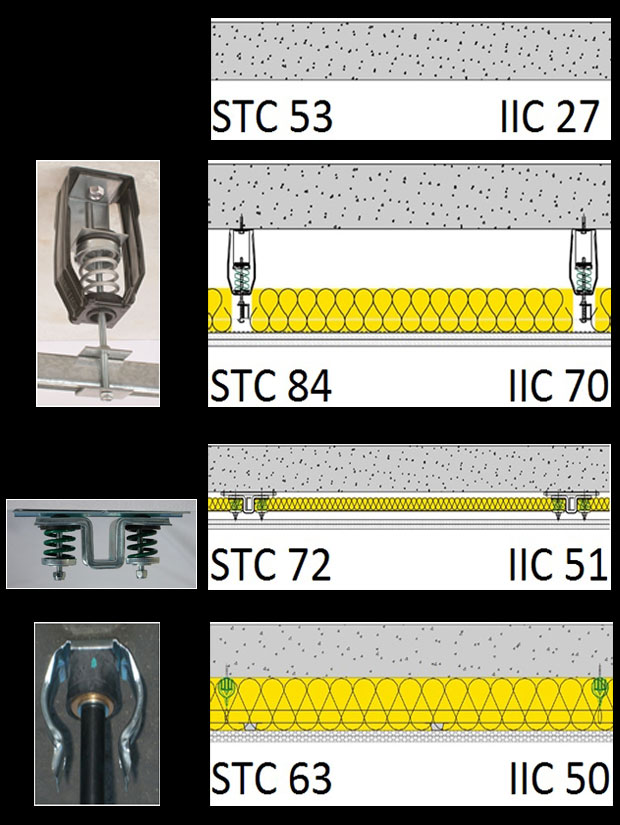
Images courtesy of Kinetics Noise Control
Ceiling noise control options for concrete construction
Top: No sound isolation system
Second from top: Addition of 1 in. deflection coil to a bare concrete ceiling slab increased STC and IIC from 53 and 27 to 84 and 70 respectively.
Third from the top: ½ in. deflection coil spring.
Bottom: Low profile easy to install neoprene hanger supports one or more layers of gypsum board below concrete slab.
NB drawings are not at the same scale
Fiberglass or neoprene hangers. These are lower cost, labor saving, non-corrosive and effective in many applications. Some products can support heavy ceilings of gypsum board and plaster. Various attachment methods allow for installation on a variety of ceiling structures, including attachment directly into concrete.
Stud Wall Design
In addition to obtaining increased STC and IIC values in floors and ceiling by specifying assemblies that include resilient isolation products, design professionals can address the design of stud walls. A single stud wall with a single gypsum board on each side has a low STC of 33. By rethinking the single stud design and adding resilient isolation products and gypsum board layers STC can be doubled.
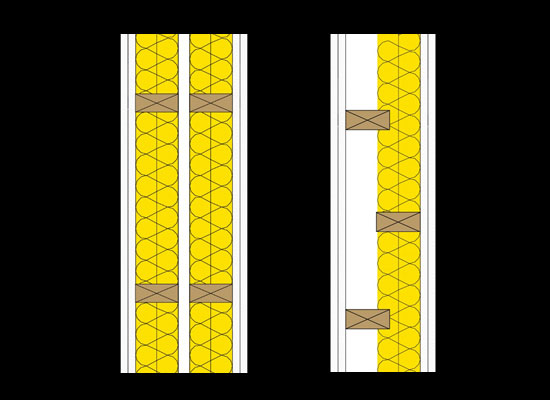
Drawings courtesy of Kinetics Noise Control
Double stud construction, left, has STC 63 and wide wall footprint. Staggered stud construction, right, has a lower STC 53 because a common base plate for studs transmits sound.
The two basic approaches to increasing sound attenuation in stud walls are designing double and staggered stud configurations; and using resilient isolation clips and channels, pads and wall braces.
Double Stud Wall
Double 2 x 4 stud wall with two layers of 5/8 in. gypsum board each side, provides STC 63 and a wall footprint 10-3/4-in.-deep. While effective for high STC, the two walls take additional floor space and have a higher material cost than single stud construction.
Staggered Stud
While much less effective than double stud construction due to common base plates, which transmit sound, staggered stud construction takes less floor space. Staggered stud construction, 2 x 4 on common 2 x 6 base and top plates with two layers of 5/8-in gypsum wallboard on both sides has STC 53. Its wall footprint is 8-1/2-in. deep.
Resilient Channel
For many years, walls and ceiling noise control was handled by installing resilient channel often referred to as RC. This continuous metal angle is attached to a stud on one side and the drywall on the other. While commonly used in many “noise control” assemblies, studies have indicated that the channel is more often than not installed either upside down or is acoustically short circuited by the accidental driving of a screw from the drywall into the wall stud.

Image courtesy of Kinetics Noise Control
Resilient channels should be installed correctly. Resilient channels are often installed upside down, above, or are the wrong type. Another common problem is “short circuiting” when screws are driven through the channel leg into the stud
Resilient Clip for Single Stud
When added to single stud construction, resilient sound isolation clips offer low-cost, space saving noise control. Attached to wall studs they can provide an STC range of 57 to 63 and secure a drywall furring channel. One or more layers of gypsum board are hung to the furring channel using common construction practices. They offer higher STC values than resilient channels. Another advantage is that installers will not inadvertently screw through the "resilient" leg of the channel into the joist or stud. This feature cannot be underestimated given the frequent, unknown occurrences where resilient channel is accidentally rendered ineffective because it is hard-attached.
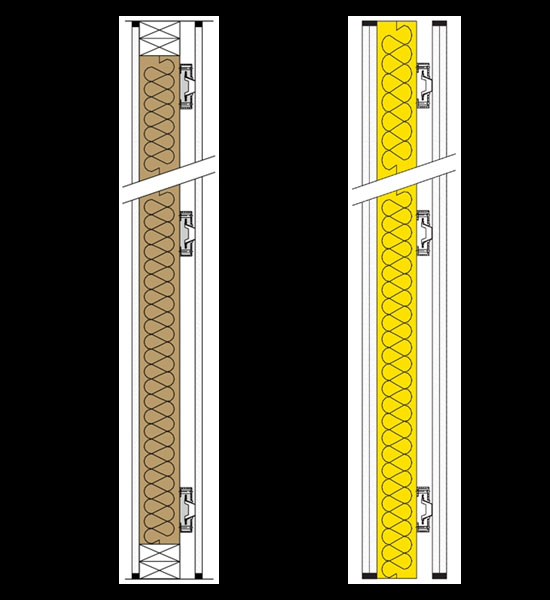
Images courtesy of Kinetics Noise Control
Isolation clip design and construction for single stud walls provide STC 57 (with single layer of gypsum board) and STC 61 (with double layer of gypsum board). For double stud construction and double layer of gypsum board with isolation clip, STC is 63. For single stud with no isolation clip, STC is 33.
Wall Isolation Pads Prevent Flanking Noise
Rarely mentioned or directly addressed, flanking noise is noise that reaches a room by an indirect path. An example would be sound reaching the room above or adjacent to a den where loud music is played from a route other than through the ceiling or wall. Resilient partition isolation pads prevent flanking noise by decoupling a sound-rated partition from a non-isolated structure. Flanking of sound through a floor/ceiling assembly can reduce STC or IIC ratings 10 points or more.
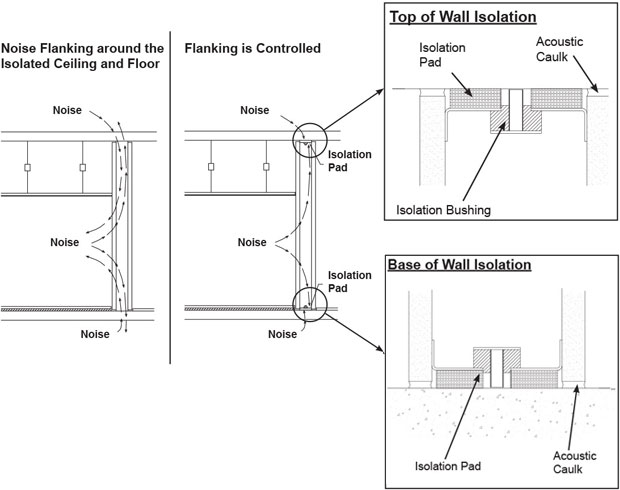
Isolation pads control flanking noise in ceiling, floor and walls.
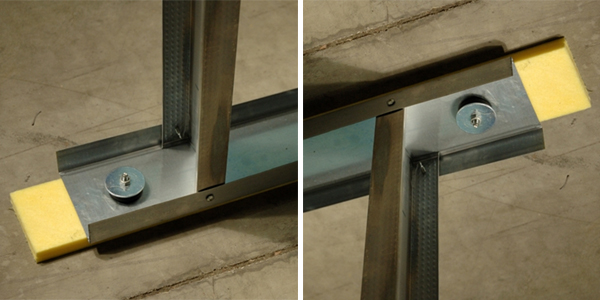
Photos courtesy of Kinetics Noise Control
Examples of isolation pads on ceilings and floors.
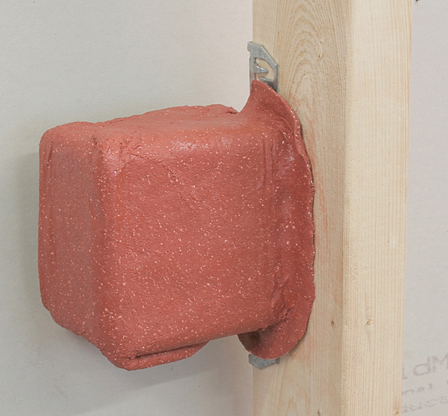
Photo provided by Kinetics Noise Control
Outlet backer putty pads maintain acoustical ratings in fire rated walls.
Acoustical Outlet Backer Pad
Outlet backer putty pads maintain acoustical ratings in fire rated walls. Classified for metallic and non-metallic boxes to prevent the spread of smoke, fire and toxic gases, they are easy to apply and will not harden. An unsealed outlet can degrade STC 5 to 10 points.
LEED®—Acoustical Treatment Can Help Earn LEED Points
LEED BD+C: Multifamily Midrise | v4 - LEED v4
Acoustic comfort
Possible 1 point
Intent
Provide acoustic comfort by minimizing intruding noise into and within buildings.
Requirements
These requirements only apply to “acoustically sensitive” rooms, such as bedrooms, dining rooms, living rooms, and studies. (“Acoustically insensitive” rooms include bathrooms, kitchens, and hallways.) Projects may also implement the measures throughout the entire home.
Option 1. Prescriptive noise reduction methods.
Meet all of the following requirements:
1. Mechanical systems must meet the following requirements:
- Continuous ventilation fans shall have a maximum sound rating of 0.7 sones. Intermittent fans shall have a maximum sound rating of 1.5 sones, unless their maximum rated airflow exceeds 400 cfm. HVAC air handlers and remote-mounted fans are exempted, if the fans are mounted outside the habitable spaces, bathrooms, and hallways, and if there is at least 4 feet of ductwork between the fan and the intake grill.
- Meet the following best-practice HVAC installation measures:
- Ducts are securely attached (no loose connections between sections of ductwork).
- The fan housing is securely anchored.
- The damper flap closes fully, with no visible airspaces around the flap.
- For projects that are less than a half a mile away from any significant noise source such as (but not limited to) aircraft over-flights, highways, trains, and industry, exterior assemblies must include:
- Exterior windows and doors must have a minimum STC rating of 35.
- All exterior wall penetrations must be sealed with acoustical sealant, and/or otherwise treated for sound control (e.g. lined elbows on vents, lined exterior ducts where feasible).
- Attached single family homes and multi-family homes must also meet the following:
- Party walls must have a minimum STC rating of 55.
- All party wall penetrations must be sealed with acoustical sealant
- Floor/ceiling assemblies must have a minimum STC and IIC rating of 55.
AND/OR
Option 2. Performance-based compliance requirements
Meet all of the following. The tested levels must be met in the acoustically sensitive room that is considered the worst case condition.
1. The maximum background noise level in the home or unit due to exterior noise sources cannot exceed 40 dBA, based on the peak hour Leq.
2. The maximum background noise level in the home or unit due to interior noise sources (HVAC systems, lighting, and other building services operating simultaneously) shall not exceed 40 dBA, based on the peak Leq.
3. Party walls must have a minimum NIC rating of 50.
4. Floor-ceiling assemblies between units must have a minimum NIC and FIIC rating of 50.
Ductless systems qualify for this credit.
Conclusion
Intrusive noise for occupants of multi-family housing elevates stress, induces stress related health issues and creates the potential for litigation. Often ignored by both developers and design professionals, sound control must be addressed during the design phase since sound control remediation is extremely expensive and impractical to implement. Design professionals are urged to consult acoustical specialists in order to achieve acoustical design goals since code requirements are generally insufficient. Strategies for isolating airborne and impact-generated sound between rooms include stud design and specifying tested and rated sound isolation products and assemblies for floors, ceilings and walls.
 |
Celebrating over 55 years, Kinetics Noise Control has extensive experience in designing and manufacturing innovative products to control sound and vibration. Established in 1958 as engineers focusing on sound and vibration control, Kinetics pioneered development of pre-compressed, molded fiberglass pad isolators that would be incorporated into an innovative new floor isolation system. Previous trade names of Kinetics Noise Control include Consolidated Kinetics and Peabody Noise Control. www.kineticsnoise.com |
